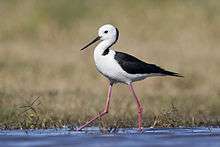Pied stilt
| Pied stilt | |
|---|---|
 | |
| Adult pied stilt | |
| Scientific classification | |
| Kingdom: | Animalia |
| Phylum: | Chordata |
| Class: | Aves |
| Order: | Charadriiformes |
| Family: | Recurvirostridae |
| Genus: | Himantopus |
| Species: | H. leucocephalus |
| Binomial name | |
| Himantopus leucocephalus Gould, 1837 | |
| Synonyms | |
| |
The pied stilt (Himantopus leucocephalus), also known as the white-headed stilt, is a bird in the family Recurvirostridae. It is sometimes considered a subspecies of the black-winged stilt (H. himantopus). This shorebird has been recorded in Malaysia, Japan, the Philippines, Brunei, Christmas Island, Indonesia, Palau, Papua New Guinea, Australia, and New Zealand.
Taxonomy
John Gould described the pied stilt in 1837. Its species name is derived from the Ancient Greek words leukos "white" and kephale "head".
"Pied stilt" has been designated the official name by the International Ornithologists' Union (IOC).[2]
Description
The pied stilt grows to a length of about 14 in (36 cm) with a wingspan of about 26.5 in (67 cm). The back of the head and neck, the back and the upper surfaces of the wings are glossy greenish-black. The undersides of the wings are plain black and the remainder of the plumage is white, apart from the tail feathers which are tinged with grey. The long, thin legs are pink and the toes have black claws. The long slender beak is black and the irises and the eyelids are red.[3]
Distribution
The pied stilt is resident in southern Sumatra, Java, Sulawesi and most of Australia, New Zealand and Papua New Guinea. There are non-breeding populations in Sri Lanka, the Philippines, Brunei, Palau, South Kalimantan, West Nusa Tenggara, East Nusa Tenggara, East Timor and New Guinea.[4] This bird is a vagrant to Japan and Christmas Island.[1]
Behaviour
_in_the_water.jpg)
The pied stilt is a waterbird and feeds in shallow water, probing into the sediment with its beak. It is gregarious, and in New Zealand sometimes forms mixed flocks with the black stilt (Himantopus novaezelandiae),[3] a bird now critically endangered.[5] It feeds largely on aquatic insects and on small molluscs. It emits a repeated yelping cry as it flies, and the legs trail behind it, tending to sway from side-to-side.[3]
The pied stilt breeds in the spring, choosing as a nesting site an area of sand or shingle by an estuary, beside a dried up riverbed, on a flat bit of coast or in a grassy field near the sea. It seems particularly attracted to locations near where the red duck-weed (Azolla rubra) flourishes. It prepares a nest in a shallow depression or in a scrape in the ground where it usually lays four, ovoido-conical eggs. These are yellowish-brown dappled irregularly with dark blotches and spots. The nest is difficult to find as the eggs are well-camouflaged. But the parent birds give away the presence of the nest by mounting into the air and flying in circles, uttering distress cries. The chicks are able to leave the nest almost as soon as they have hatched. They are difficult to detect because their downy plumage is well-camouflaged and they "freeze" when alarmed. A parent bird sometimes feigns a leg injury to draw intruders away from its chicks.[3]
Status
The pied stilt is widely distributed with a large total population size and apparently stable population trend. It is listed as Least Concern on the IUCN Red List.[1]
References
- 1 2 3 BirdLife International (2016). "Himantopus himantopus". IUCN Red List of Threatened Species. IUCN. 2016: e.T22727969A86541570. doi:10.2305/IUCN.UK.2016-3.RLTS.T22727969A86541570.en. Retrieved 10 May 2017.
- ↑ Gill, Frank; Donsker, David, eds. (2017). "Buttonquail, plovers, seedsnipe, sandpipers". World Bird List Version 7.1. International Ornithologists' Union. Retrieved 27 January 2018.
- 1 2 3 4 Buller, Sir Walter Lawry (1888). A History of the Birds of New Zealand: Himantopus leucocephalus,. pp. 21–23.
- ↑ "White-headed Stilt · Himantopus leucocephalus Gould, 1837". Xeno-canto Foundation. Retrieved 2014-06-12.
- ↑ BirdLife International (2016). "Himantopus novaezelandiae". IUCN Red List of Threatened Species. Version 2018-1. International Union for Conservation of Nature. doi:10.2305/IUCN.UK.2016-3.RLTS.T22693690A93418187.en
External links


